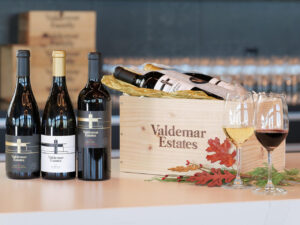Usually during the holidays, even the most-tightfisted among us tend to unclench. But this year, things may be different.
By Kathleen Willcox
How are wine sales going so far for producers, and what is their outlook for the holidays and next year? It depends who you ask — but don’t get your hopes up.

“Across the board, 2022 isn’t as good as 2021,” says Rob McMillan, EVP and founder of the Silicon Valley Bank Wine Division, and author of the annual State of the Wine Industry Report. “Volume is down across the business, and holiday sales will probably be somewhat muted for wine. And with a straining economy, we’ll probably see a restrained consumer and lower total spend versus 2021.”
Most large producers are showing sales declines, he continues, but adds that sales “continue to produce better returns” in the premium sector and are up overall.
McMillan also says the Sentiment Index he created six years ago, to measure how wine pros feel about the state of the market, is currently at -15.78 compared with -2.08 at the same time last year. (The maximum negative is -100, and the maximum high is +100).
A quick look at other broad data points fails to uplift. Overall consumer sentiment in the U.S. has plummeted to its second-lowest point this year, according to the latest Ipsos-Forbes Advisor Consumer Confidence Tracker, with perceptions about job security and the jobs market at their lowest level in 15 months. More alarmingly for those in the business of selling things, nearly seven in 10 are less comfortable making major purchases, and two-thirds are less comfortable snagging items for the home.
What About Holiday Spending?
Usually during the holidays, even the most-tightfisted among us tend to unclench. But this year, higher than usual rates of financial anxiety may keep a white-knuckled stranglehold on spending.

About 82% of shoppers say they intend to look for deals and discounts before making a purchase, and 72% plan to seek out less expensive options for gifts, according to Morning Consult’s Consumers 2022 Holiday Plans report. More alarmingly for industry watchers, 42% plan to spend less on alcohol this year.
Cathy Huyghe, co-founder of Enolytics, a data analytics company for wine, says her team will be watching the numbers roll in from the holidays quite carefully.
“In the case of direct-to-consumer [DTC] wine sales for 2022, the data reflects general trends and concerns in the economy,” Huyghe says. “In a nutshell, the first quarter of 2022 was up, the second quarter was flat, and the third quarter was slightly down. We’re curious to see how far the fourth quarter — holiday and gifting season — goes toward making up for slower revenues. This year also, since we now combine DTC and depletion data together, will provide some interesting all-channel data to measure.”
Pain for Value Priced Wines
U.S. importers like Banfi, meanwhile, are predicting pain for value-priced wines, but a good year for premium sales.
“Our revenue has been solid this year, driven by growth on Brunello and super premium wines,” Banfi’s owner and CEO, Cristina Mariani-May says. “Despite Banfi portfolio growth overall, what we’re seeing so far is a sensitivity to price for consumers shopping the key retail price points from $9.99 to $14.99. Interestingly though, we’re not seeing the same pattern impact the super-premium consumer and our outlook going into the holidays is positive, with continued growth expected for Brunello and our super premium selections.”
Wins and Losses for Premium Wines
The top echelon of the wine world is doing well, but just not as well as it could be.
 “We project we will close the year at +8% year-over-year,” says Jesús Martínez Bujanda Mora, CEO and owner of Valdemar Family Estates, which has wineries in Walla Walla, Wash., and La Rioja, Spain, and sells bottles for between $40 to $85. “We were expecting to grow more but the economic situation has slowed us significantly. Interestingly, club growth and retention has been better than expected.”
“We project we will close the year at +8% year-over-year,” says Jesús Martínez Bujanda Mora, CEO and owner of Valdemar Family Estates, which has wineries in Walla Walla, Wash., and La Rioja, Spain, and sells bottles for between $40 to $85. “We were expecting to grow more but the economic situation has slowed us significantly. Interestingly, club growth and retention has been better than expected.”
Overall, sales at Napa’s Domaine Carneros, where bottles retail for $32 to $125, are up year-over-year. But CEO Remi Cohen is quick to put that in context.
“Revenue is slightly ahead of last year, but we were closed for visitation most of January 2021 due to Napa County pandemic requirements,” Cohen says. “We’ve been seeing slightly lower sales in our visitor center this summer and fall compared to the record-breaking second half of 2021, but [the numbers] are still very strong and significantly ahead of 2019. Our wine club remains a bright spot, up 15% from prior year. We’ve seen a decline in the ecommerce and phone channels which surged in 2020 and 2021, though those channels are stronger than they were pre-pandemic.”

Jeff Smith, chief wine officer at wine storage network and strategic wine asset management firm Vino Vault concurs that while business has been slightly off for the premium sector, it’s doing comparably well.
“The fine wine auction market is not impervious to larger economic forces — markets, unemployment, wealth disparity,” Smith notes. “Still, it is largely insulated from the worst of it. Wine is off by about 10 to 15% from the high, but not 25 to 35% like other markets. We are still at near-record highs. The market seems to be strong in terms of sell-through in the estimate range.”
Outlook Is Less Bullish
Concerns over logistics and climate change are dampening outlooks for 2023, and businesses say they’re taking steps to control what they can.
“Supply chain lead times, transportation and inventory continue to be our industry’s biggest challenges. The only good thing about that is, it’s not new,” says Mariani-May. “Banfi’s distributor partners have made a concerted effort to carry more inventory. We have also extended what we maintain stateside so that we are in a better position to react quickly to programs, take advantage of market opportunities and offer more flexibility to our customers.”
For producers exporting to the U.S., the road ahead — even after solid gains in sales last year — will be rough due to supply challenges and increased costs across the board.
“Since 2020 at Maso Martis, we have experienced a steady growth in revenue, which increased by 30%,” says Alessandra Stelzer, communication and hospitality manager at Trentodoc, Italy’s Maso Martis. “The main obstacle our U.S. importer has been facing in recent years is the crazy increase in transport costs. Our main concerns are the increasingly growing costs — and scarce availability — of the material we need to bottle, pack and stock the wine.”
Weather and Climate Change Effects
Wine producers are used to dealing with vintage variation, but many have become increasingly alarmed by the extremes imposed by climate change, and are taking whatever steps they can in the vineyard, cellar and tasting room, to mitigate them.

“What’s been particularly challenging has been the extremity of weather conditions and climate issues, and we hope to see some alleviation from the drought and a return to a more normal yielding vintage after the last three drought-impacted vintages,” Cohen says. “We’re still navigating supply chain issues and long leads for ordering supplies, so we’ve been planning ahead and placing orders early to the best of our ability. Overall, we have a cautiously positive outlook as we look to 2023.”
Cohen adds that next year will be Domaine Carneros’ first year operating with its updated solar microgrid, which will let the estate maintain energy independence and reduce its carbon footprint. Domaine Carneros is also investing in a kitchen remodel to support its expanding elevated culinary pairing experiences and bring more traffic into the tasting room.
Downward Drinking
The party for the premium sector has been raging for years, even as value-priced wine has struggled in recent months. But, Smith cautions, a correction may be on the horizon, even for the most elevated producers.
“One thing to expect, if the overall economy goes into recession or stays mired in this quasi-recession with high inflation, is that consumption won’t change, but you may see the average price per bottle coming down,” Smith says. “People will still drink at the same volume level but with less expensive choices.”
___________________________________________________________

Kathleen Willcox
Kathleen Willcox writes about wine, food and culture from her home in Saratoga Springs, N.Y. She is keenly interested in sustainability issues, and the business of making ethical drinks and food. Her work appears regularly in Wine Searcher, Wine Enthusiast, Liquor.com and many other publications. Kathleen also co-authored a book called Hudson Valley Wine: A History of Taste & Terroir, which was published in 2017. Follow her wine explorations on Instagram at @kathleenwillcox

















